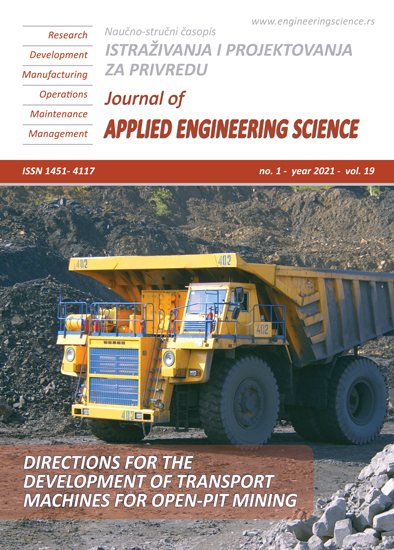PREDICTING THE TYPE OF PHYSICAL ACTIVITY FROM TRI-AXIAL SMARTPHONE ACCELEROMETER DATA
Abstract
Development of various statistical learning methods and their implementation in mobile device software enables moment-by-moment study of human social interactions, behavioral patterns, sleep, as well as their physical mobility and gross motor activity. Recently, through the use of supervised Machine Learning, human activity recognition (HAR) has been found numerous applications in biomedical engineering especially in the field of digital phenotyping. Having this in mind, in this research in order to be able to quantify the human movement activity in situ, using data from portable digital devices, we have developed code which uses Random Forest Classifier to predict the type of physical activity from tri-axial smartphone accelerometer data. The code has been written using Python programing language and Anaconda distribution of data-science packages. Raw accelerometer data was collected by using the Beiwe research platform, which is developed by the Onnela Lab at the Harvard T.H. Chan School of Public Health. Tuning has been performed by defining a grid of hyperparameter ranges, using Scikit-Learn’s Randomized Search CV method, randomly sampling from the grid and performing K-Fold CV with each combination of tested values. Obtained results will enable development a more robust models for predicting the type of physical activity with more subjects, usage of different hardwares, various test situations, and different environments.
References
/1/ Cook, D. J., Das, S. K. (2012),: “Pervasive computing at scale: Transforming the state of the art”; Pervasive Mobile Computing; 8 22–35
/2/ D.J. Cote, I.Barnett, J.P. Onnela, T.R.Smith (2019), Digital Phenotyping in Patients with Spine Disease: A Novel Approach to Quantifying Mobility and Quality of Life World NeurosurgeryVolume 126, Pages e241-e249
/3/ N.Panda , I Solsky, E Huang, C Lipsitz, J Pradarelli, D Delisle, J Cusack, M Gadd, C Lubitz, J Mullen, M Qadan, B Smith, M Specht, A Stephen, K Tanabe, A Gawande, JP Onnela, (2020) A Haynes Utilizing smartphones to capture novel recovery metrics after cancer surgery JAMA Surg.;155(2):123-129. doi:10.1001/jamasurg.2019.4702
/4/ C Stroud, JP Onnela* and H Manji (2019)Harnessing digital technology to predict, diagnose, monitor, and develop treatments for brain disorders Digital Medicine 2:44
/5/ D. Anguita, A. Ghio, L. Oneto, X.Parra, J. L. Reyes-Ortiz. (2013)Energy Efficient Smartphone-Based Activity Recognition using Fixed-Point Arithmetic. Journal of Universal Computer Science. Special Issue in Ambient Assisted Living: Home Care. Vol. 19, Issue 9
/6/ D. Anguita, A. Ghio, L. Oneto, X. Parra, J. L. Reyes-Ortiz. Human (2012), Activity Recognition on Smartphones using a Multiclass Hardware-Friendly Support Vector Machine. 4th International Workshop of Ambient Assited Living, IWAAL 2012, Proceedings. Lecture Notes in Computer Science pp 216-223
/7/ J.L. Reyes-Ortiz, A. Ghio, X. Parra-Llanas, D. Anguita, J. Cabestany, A. Català. Human Activity and Motion Disorder Recognition: Towards Smarter Interactive Cognitive Environments. 21th European Symposium on Artificial Neural Networks, Computational Intelligence and Machine Learning, ESANN 2013. Bruges, Belgium 24-26 April 2013.
/8/ Jason Brownlee How to Model Human Activity From Smartphone Data, Mashine Learning Mastery, https://machinelearningmastery.com/how-to-model-human-activity-from-smartphone-data/
/9/ Emily Huang, Jukka-Pekka Onnela Activity Classification Using Smartphone Gyroscope and Accelerometer Data Published in ArXiv 2019 Computer Science
/10/ Vapnik, V. N.: The nature of statistical learning theory; Springer-Verlag New York, 1995
/11/ Maurer, U., Smailagic, A., Siewiorek, D., Deisher, M.: “Activity recognition and monitoring using multiple sensors on different body positions”;InternationalWorkshop onWearable and Implantable Body Sensor Networks; 2006
/12/ Jatoba, L. C., Grossmann, U., Kunze, C., Ottenbacher, J., Stork,W.: “Context-aware mobile health monitoring: Evaluation of different pattern recog nition methods for classification of physical activity”; International Conference of the IEEE Engineering in Medicine and Biology Society; (2008)
/13/ Mannini, A., Sabatini, A. M. (2010), Machine learning methods for classifying human physical activity from on-body accelerometers, Sensors, 2, 1154–1175
/14/ J. Wang, Y. Chen, S. Haoc, X. Peng, L. Hu (2018) Deep Learning for Sensor-based Activity Recognition: A Survey Pattern Recognition Letters 1-9
/15/ C. J. Caspersen, K. E. Powell, and G. Christenson, (1985) Physical activity, exercise and physical fitness: definitions and distinctions for health-related research, PublicHealth Reports, vol. 100, no. 2, pp. 126–131
/16/ M. Suzuki, H. Mitoma, M. Yoneyama (2017), Quantitative Analysis of Motor Status in Parkinson’s Disease Using Wearable Devices: From Methodological Considerations to Problems in Clinical Applications Hindawi Parkinson’s Disease Article ID 6139716,
/17/ J. J. Kavanagh, H. B. Menz, Accelerometry: a technique for quantifying movement patterns during walking, Gait and Posture, vol. 28, no. 1, pp. 1–15, (2008)
/18/ K. Aminian, B. Najafi, (2004) Capturing human motion using body-fixed sensors: outdoor measurement and clinical applications,Computer Animation and Virtual Worlds, vol. 15, no. 2, 79–94
/19/ W. Maetzler, J. Domingos, K. Srulijes, J. J. Ferreira, B. R.Bloem, (2013) Quantitative wearable sensors for objective assessment of Parkinson’s disease, Movement Disorders, vol. 28, no. 12, pp.1628–1637

